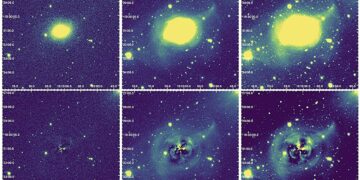The universe never ceases to amaze us, and the recent exploration of the NGC 5018 galaxy group has added yet another piece to the cosmic puzzle. Using the advanced capabilities of the VLT Survey Telescope (VST), astronomers from Italy and Germany have shed light on the intricate system of globular clusters (GCs) within this galaxy group.
The NGC 5018 Galaxy Group: A Cosmic Treasure Trove
The NGC 5018 galaxy group is a fascinating ensemble of galaxies located approximately 132.5 million light-years away in the Virgo constellation. At its heart lies NGC 5018, a massive elliptical galaxy surrounded by other prominent members, including the spiral galaxies NGC 5022 and NGC 5006, as well as two lenticular galaxies, MCG-03-34-013 and PGC 140148.
Astronomers have long been intrigued by this galaxy group due to its diverse components and unique interactions. As the brightest member, NGC 5018 serves as a focal point for studying the dynamics and evolution of galaxies within the group. The gravitational interplay among these galaxies creates a dynamic environment that influences their development, star formation, and globular cluster systems.
Globular Clusters: The Cosmic Building Blocks
Globular clusters are tightly bound collections of stars that orbit galaxies. These clusters act as natural laboratories for studying stellar evolution and galactic history. GCs are particularly valuable for understanding early-type galaxies like NGC 5018, as their origins are closely tied to intense periods of star formation.
Previous studies revealed that NGC 5018 hosts two distinct GC populations: a smaller, younger group aged between several hundred million and six billion years, and a larger, older population. This diversity offers a unique opportunity to study different stages of stellar and galactic evolution.
The Observational Campaign: Harnessing the Power of the VLT Survey Telescope
The latest breakthrough comes from the VEGAS (VST Elliptical Galaxy Survey) project, which leverages the advanced imaging capabilities of the VLT Survey Telescope. Led by Pratik Lonare of the Abruzzo Astronomical Observatory, the research team conducted a systematic study of the GC system within the NGC 5018 galaxy group.
The VEGAS imaging data enabled astronomers to identify thousands of globular cluster candidates across the galaxy group. The data revealed an intra-group GC system—clusters distributed not just within individual galaxies but also in the space between them. This intra-group component aligns with the detected intra-group light (IGL), further illustrating the interconnected nature of the galaxy group.
Key Findings: Mapping the GC System
The study uncovered several remarkable features of the GC system in the NGC 5018 galaxy group:
- Cluster Distribution: The 2D distribution map highlighted a significant concentration of GCs around NGC 5018, while other galaxies in the group showed relatively sparse populations. This distribution suggests that NGC 5018 plays a central role in shaping the GC system.
- Intra-Group Components: The intra-group GC population extends beyond the immediate vicinity of the galaxies, forming a network that surrounds the entire group. This geometry closely follows the IGL pattern, which is believed to result from tidal interactions between galaxies.
- Color and Composition: The GCs in NGC 5018 exhibit two distinct color components: blue and red. The blue clusters are more extended and likely originated within NGC 5018 before being dispersed by tidal forces. The red clusters, on the other hand, are concentrated closer to the galaxy.
- Cluster Numbers: The team estimated approximately 4,000 GC candidates for the entire group, with 485 of them associated specifically with NGC 5018. This extensive dataset provides a robust foundation for future studies of GC systems.
The Science Behind the Findings
The observations offer valuable insights into the processes that shape galaxies and their clusters. The presence of blue and red GC populations, combined with their spatial distribution, suggests that tidal interactions have played a significant role in redistributing clusters within the group. These interactions likely stripped blue GCs from NGC 5018, dispersing them into the intra-group space.
Moreover, the study’s focus on the alignment between GCs and IGL highlights the role of cluster dynamics in tracing the history of galaxy interactions. By examining these patterns, astronomers can infer the gravitational forces at play and better understand the mass distribution within the group.
A Bright Future for Galactic Research
As technology continues to advance, the possibilities for exploring the cosmos are expanding. Future observations using next-generation telescopes, such as the James Webb Space Telescope, could provide even deeper insights into globular cluster systems and their role in galactic evolution.
In the meantime, the findings from the NGC 5018 galaxy group serve as a testament to the power of collaborative research and innovative methodologies. By combining cutting-edge technology with a deep curiosity about the universe, astronomers are unraveling the mysteries of the cosmos, one discovery at a time.
Conclusion: Unlocking the Secrets of the Stars
The study of globular clusters in the NGC 5018 galaxy group is a significant step forward in our quest to understand the universe. Through meticulous observations and innovative analysis, astronomers have mapped a complex system of clusters that sheds light on the dynamics of galaxy groups and their evolution.
Reference:



















